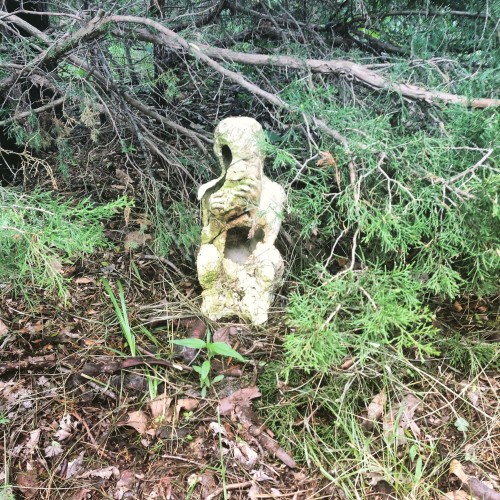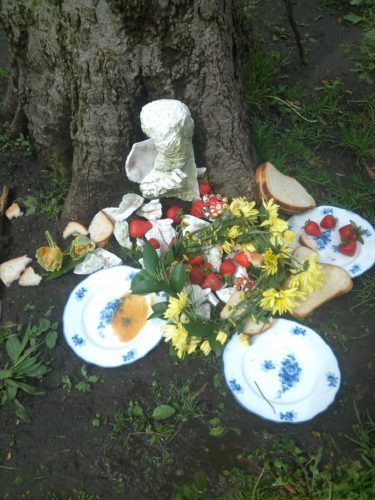Pagan Perspectives
“Somebody killed Pan,” she said.
My best friend Sarah and her family had staked out a plot of land at the Gaea Retreat outside of Kansas City as their favorite campsite. It was a secluded spot, just big enough for three tents, tucked to the side of the gravel road and wire fence that marked one edge of Gaea. They called it Shamballa, which invariably made me think of the Three Dog Night song – I can tell my sister by the flowers in her eyes, on the road to Shamballa.
Underneath an evergreen tree inside the entrance to Shamballa, Sarah had placed an old concrete idol of the god Pan. I never knew of a time when her family didn’t have that statue. I had seen Pan sitting on a tree stump in the front yard when I stayed with Sarah and her brothers during the summers when I was a child. It seemed like everyone we knew had a Pan statue around their homes in those days; my parents had an identical Pan sitting on a shelf in their house, painted in latex, the deep grooves of his eyebrows filled with ruddy shades.

Pan in Shamballa [E. Scott].
That is, until somebody backed their truck into him, leaving the weathered old god as a collection of masonry scraps.
When Sarah told me this, my mind went first to Plutarch, who recorded the famous anecdote of the Egyptian sailor named Thamus., who supposedly heard a divine voice tell him to announce at his next port that great Pan was dead; unsure of whether to believe in the strange command, he decided he would ignore it if there were a wind to sail them past, and obey if there were no wind. There was no wind, so he made the announcement.
When he came opposite Palodes, and there was neither wind nor wave, Thamus from the stern, looking toward the land, said the words as he had heard them: ‘Great Pan is dead.’ Even before he had finished there was a great cry of lamentation, not of one person, but of many, mingled with exclamations of amazement.
The Emperor Tiberius heard the story and called for Thamus, and became convinced of its truth – that Great Pan was indeed dead.
Christian writers from Eusebius to Chesterton have made great sport with Plutarch’s anecdote; for them, the death of Pan signaled the dawning of the Christian era, where the enlightenment of the new religion would sweep away the darkness of the Pagan past. In his early poem “On the Morning of Christ’s Nativity,” Milton invokes the death of Pan in response to Christ’s birth:
The Shepherds on the Lawn,
Or ere the point of dawn,
Sate simply chatting in a rustic row;
Full little thought they than,
That the mighty Pan
Was kindly come to live with them below:
Perhaps their loves, or els their sheep,
Was all that did their silly thoughts so busy keep.
For most of the Christian era, the death of Pan was a triumph, but in the Romantic era, the invocation of the god’s death began to take on a more tragic mien. Though Elizabeth Barrett Browning’s poem “The Dead Pan” ends with the image of Christ overthrowing the “false gods” by the power of the “love [Christ] stood alone in,” the tone with which she describes the loss of those gods can only be called elegiac:
Gods! we vainly do adjure you, –
Ye return nor voice nor sign!
Not a votary could secure you
Even a grave for your divine!
Not a grave, to show thereby,
Here these gray old gods do lie.
Pan, Pan is dead.
By the early 20th century, some poets had dropped the pretense of Christian triumph and gave themselves entirely to the elegy. My favorite of these is Eleanor Farjeon’s “Pan-Worship,” published in 1908, in which the speaker describes a Pan much like the one that belonged to Sarah: “Here on its time-defaced pedestal / The image of a half-forgotten god / Crumbles to its complete oblivion.” The speaker, longing for the enchantment of the Pagan world that Pan represents, entreats the idol in hopes of bringing it back to life:
If I kneel,
Bend and adore, make sacrifice to thee,
If to thy long-deserted fane I bring
Tribute of milk and honey—then if I snap
That loveliest pipe of all at the spring’s margin
And let the song of Syrinx from its hollow,
Nay, even the nymph’s sweet self—O Pan, old Pan,
Shall I not see thee stirring in the stone,
Crack thy confinement, leap forth—be again?
The poem rises into a rapturous climax, the speaker chanting, “Pan! Pan! O Pan! bring back thy reign again upon the earth!” Then Farjeon, after a heart-stopping line break, brings the elegy to its conclusion:
Numb pointed ears, ye hear
Only the wash and whisper of far waters,
The pale green waters of thin distant springs
Under the pale green light of distant moons
Washing upon the shores of the old, old world
With a foam of flowers, a foam of whispering flowers.
This, ultimately, is what the romantic spirit is about: a poem like Farjeon’s expresses the loss felt in modern life, the lack and longing for a way of living that is enchanted and unalienated. Romanticism, for all the beauty with which it expresses this longing, does not have the means to alleviate it; the romantic can only look to the imagined past and wish that it might come again, knowing that it cannot.
In short, this is the difference between the romantic worldview and the Pagan worldview. Paganism is bound up in romanticism, and could not exist without it, but unlike the romantics, Pagans can look upon the mute face of aged Pan and realize that there are options beyond simply longing for the days in which he still lived. Romantics long for a magick that seems gone, but Pagans know that magick still exists; Pagans know that if Pan is dead, Pan can live again.

Pan with offerings [E. Scott].
The sabbat ritual is an unusual genre, at least the way we do it – it calls for variations on a theme, the production of a new work on an old story. Every sabbat ritual I’ve performed has been a new composition, but one built atop the lessons I’ve learned from my lifetime of attendance at other celebrations of the holiday. The theme of Beltane, in particular, has always been that of new possibilities, energy coming into this world from the numinous world beyond, so it was with this ritual: we would take the broken shards of Sarah’s Pan and bring them back to life.
Reading verses from Farjeon’s poem, we circled the tree, offering gifts to the broken Pan: strawberries, dandelions, plates of honey and saucers of milk. But the stone remained mute. Our offerings, it seemed, were as futile as the romantics’. Pan continued to be a shattered idol, a god with no hope of resurrection.
One of number, dressed as a nymph, stepped forward and knelt before Pan. She caressed his scarred brow and his chipped fingers. “I will thrill thee back from the dead ages,” she said to the statue, and she threw her head back and cried. “Pan! Pan! O Pan! Bring back thy reign upon the earth!” We closed our eyes and joined her: “Pan! Pan! O Pan! Bring back thy reign upon the earth!”
We called and sang and chanted, feeling the Beltane magick flow up from the earth into our limbs and blood. I thought of the broken Pan statue, of the years it had spent in the rain and snow, of the truck whose driver had smashed him and then drove away without leaving a note. I thought of the centuries in which the Pagan spirit had seemed irretrievably dead, where Pan was reduced to a religious curiosity or a fable, where the only choices seemed to be an embrace of the disenchanted modern world or an inescapable longing for an age that would never come again. As our chanting built to its crescendo, I thought instead of building a world where enchantment could live again.
I opened my eyes and, standing in the middle of our circle, above the broken stone of Pan the statue, stood the lovely flesh and fur of Pan the god. He laughed, played an air on his pipes, and then offered a ribbon to his nymph, inviting her — and the rest of us — to our May Day dance.
* * *
The views and opinions expressed by our diverse panel of columnists and guest writers represent the many diverging perspectives held within the global Pagan, Heathen and polytheist communities, but do not necessarily reflect the views of The Wild Hunt Inc. or its management.
The Wild Hunt is not responsible for links to external content.
To join a conversation on this post:
Visit our The Wild Hunt subreddit! Point your favorite browser to https://www.reddit.com/r/The_Wild_Hunt_News/, then click “JOIN”. Make sure to click the bell, too, to be notified of new articles posted to our subreddit.
